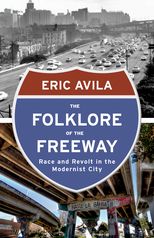The Folklore of the Freeway: Race and Revolt in the Modernist City
The Folklore of the Freeway: Race and Revolt in the Modernist City
Cite
Abstract
The Folklore of the Freeway provides an alternative history of highway construction in urban America, emphasizing the cultural politics of fighting freeways in the inner city. Using the methods of ethnic studies, cultural studies, and urban history, this book offers a revisionist history of the freeway revolt in urban America, that moment when neighborhood activists organized against state highway builders to defend the integrity of their communities. While historical accounts of the freeway revolt emphasize successful forms of grassroots mobilization within predominantly white, middle-class urban communities, the urban neighborhoods that bore the brunt of urban highway construction, lacking political and economic power, devised a creative set of cultural strategies to express opposition towards the routing of freeways through their neighborhoods. These expressions, taking shape through visual and literary cultural forms, iterates the destructive consequences of the Interstate highway program, helping to preserve communal integrity and identity and inventing new relationships between people and the urban built environment. This book thus considers the cultural dimensions of this freeway revolt, emphasizing the role of culture and identity in mediating the relationship between inner city communities and the disruptive process of infrastructural development. Losers, perhaps, in the fight against the freeway, these racially and ethnically diverse communities of working class men and women nonetheless innovated a genre of cultural expression that shapes our understanding of the urban landscape and influences the shifting priorities of urban policy since the 1960s.
-
Front Matter
-
Introduction: The Invisible Freeway Revolt
-
1
The Master’s Plan: The Rise and Fall of the Modernist City
-
2
“Nobody but a Bunch of Mothers”: Fighting the Highwaymen during Feminism’s Second Wave
-
3
Communities Lost and Found: The Politics of Historical Memory
-
4
A Matter of Perspective: The Racial Politics of Seeing the Freeway
-
5
Taking Back the Freeway: Strategies of Adaptation and Improvisation
-
Conclusion
Identity Politics in Post-Interstate America
-
End Matter
Sign in
Personal account
- Sign in with email/username & password
- Get email alerts
- Save searches
- Purchase content
- Activate your purchase/trial code
Institutional access
-
Sign in through your institution
- Sign in with a library card Sign in with username/password Recommend to your librarian
Institutional account management
Sign in as administratorPurchase
Our books are available by subscription or purchase to libraries and institutions.
Purchasing information| Month: | Total Views: |
|---|---|
| October 2022 | 6 |
| October 2022 | 5 |
| October 2022 | 5 |
| October 2022 | 8 |
| October 2022 | 6 |
| October 2022 | 4 |
| October 2022 | 1 |
| November 2022 | 2 |
| November 2022 | 2 |
| December 2022 | 3 |
| December 2022 | 1 |
| June 2023 | 3 |
| June 2023 | 1 |
| June 2023 | 1 |
| August 2023 | 2 |
| August 2023 | 2 |
| August 2023 | 2 |
| August 2023 | 2 |
| August 2023 | 2 |
| August 2023 | 2 |
| August 2023 | 2 |
| January 2024 | 2 |
| January 2024 | 2 |
| January 2024 | 2 |
| January 2024 | 1 |
| January 2024 | 1 |
| February 2024 | 2 |
| April 2024 | 1 |



Get help with access
Institutional access
Access to content on Oxford Academic is often provided through institutional subscriptions and purchases. If you are a member of an institution with an active account, you may be able to access content in one of the following ways:
IP based access
Typically, access is provided across an institutional network to a range of IP addresses. This authentication occurs automatically, and it is not possible to sign out of an IP authenticated account.
Sign in through your institution
Choose this option to get remote access when outside your institution. Shibboleth/Open Athens technology is used to provide single sign-on between your institution’s website and Oxford Academic.
If your institution is not listed or you cannot sign in to your institution’s website, please contact your librarian or administrator.
Sign in with a library card
Enter your library card number to sign in. If you cannot sign in, please contact your librarian.
Society Members
Society member access to a journal is achieved in one of the following ways:
Sign in through society site
Many societies offer single sign-on between the society website and Oxford Academic. If you see ‘Sign in through society site’ in the sign in pane within a journal:
If you do not have a society account or have forgotten your username or password, please contact your society.
Sign in using a personal account
Some societies use Oxford Academic personal accounts to provide access to their members. See below.
Personal account
A personal account can be used to get email alerts, save searches, purchase content, and activate subscriptions.
Some societies use Oxford Academic personal accounts to provide access to their members.
Viewing your signed in accounts
Click the account icon in the top right to:
Signed in but can't access content
Oxford Academic is home to a wide variety of products. The institutional subscription may not cover the content that you are trying to access. If you believe you should have access to that content, please contact your librarian.
Institutional account management
For librarians and administrators, your personal account also provides access to institutional account management. Here you will find options to view and activate subscriptions, manage institutional settings and access options, access usage statistics, and more.